Fashion & Textile History Gallery
December 4, 2012 – May 8, 2013
Exhibition website
Fashion and technology have a fast-paced and continually evolving relationship. Today,
the term techno-fashion is used to refer to a predominantly 21st-century phenomenon,
but technological advancements were shaping fashion design and fabrication as early
as the mid-eighteenth century. As fashion writer Bradley Quinn observes, Technology
has always been the essence of fashion...The fast-paced progress of technology complements
fashions ever-evolving aesthetic, and each gives the other a wider frame of reference
and more scope to explore new horizons.
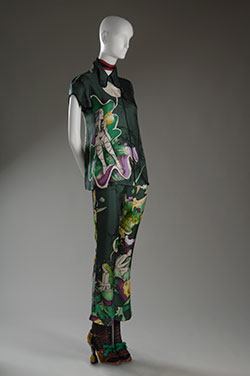
Prada, ensemble, green silk twill with multicolor print, spring 2008, Italy, gift
of Prada.
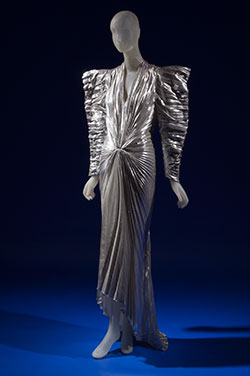
Thierry Mugler, evening dress, silver metallic lam, c. 1979, France, gift of Clarins
Fragrance Group/Thierry Mugler Perfume.
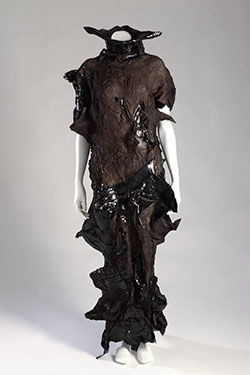
Yoshiki Hishinuma, dress, black sheer polyester/polyurethane, fall 1999-00, Japan,
gift of Hishinuma Associates Co., Ltd.
Fashion and Technology explored the impact of emerging technologies on the nature of fashion design and
production over the past 250 years. The exhibition focused on innovations that have
influenced the production, materials, aesthetic, and function of fashion. It began
with objects created during the Industrial Revolution of the 18th and 19th centuries,
when innovations in textile manufacturing revolutionized the fashion industry. These
innovations included the introduction of the Spinning Jenny, the Jacquard loom, and
the sewing machine. The exhibition then continued chronologically to the present day.
In the first decades of the 20th century, technology rapidly transformed the urban landscape, exemplified by the tall buildings that began to rise, nicknamed skyscrapers. As a way to express these technological changes, the Art Deco movement introduced a heavily geometric aesthetic to art and design, which crossed over into fashion in the form of decorative motifs. Innovations in rubber and plastic also found a variety of applications in fashionable items that include athletic shoes and eveningwear.
In the first decades of the 20th century, technology rapidly transformed the urban landscape, exemplified by the tall buildings that began to rise, nicknamed skyscrapers. As a way to express these technological changes, the Art Deco movement introduced a heavily geometric aesthetic to art and design, which crossed over into fashion in the form of decorative motifs. Innovations in rubber and plastic also found a variety of applications in fashionable items that include athletic shoes and eveningwear.
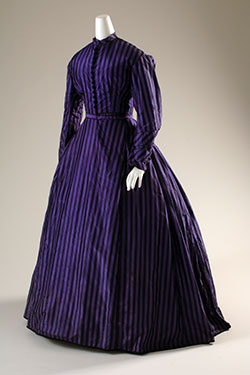
Afternoon dress, purple and black silk taffeta using synthetic analine dye, c.1860,
England, museum Purchase.
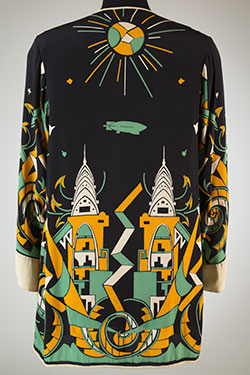
Jacket, printed with engineered Art Deco design of skyscrapers, black silk crepe,
c.1926-29, USA, museum purchase.

Clutch, black leather, red plastic, electrical plug and outlet closure, 1935-45, USA,
museum purchase.
Following World War II, fashions engagement with technology surged again. Parisian
couturiers Pierre Cardin and André Courrèges cited the Space Race as a primary inspiration
for their new, youthful fashions. With the first men orbiting the earth in 1961, it
seemed apparent to these 1960s designers that an era of recreational space travel
was just around the corner. Therefore, they created looks that the fashionable woman
could wear on a jaunt to outer-space.
In the late 20th century, the rapid spread of personal computers and the introduction of the internet transformed culture. The impact of this transformation on fashion was felt when designers such as Jean-Paul Gaultier turned to cyber space for aesthetic inspiration, and software programs like Computer Aided Design (CAD) and computer-operated Jacquard looms began to alter the ways garments were produced.
In the late 20th century, the rapid spread of personal computers and the introduction of the internet transformed culture. The impact of this transformation on fashion was felt when designers such as Jean-Paul Gaultier turned to cyber space for aesthetic inspiration, and software programs like Computer Aided Design (CAD) and computer-operated Jacquard looms began to alter the ways garments were produced.
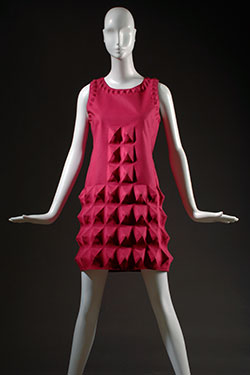
Pierre Cardin, dress, fuchsia Cardine textile with molded 3D shapes, 1968, USA, gift
of Lauren Bacall.
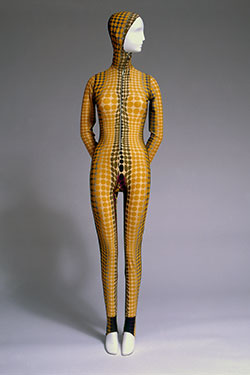
Jean Paul Gaultier, jumpsuit, multicolored nylon and spandex with Op-Art cyber graphic
print, 1996, France, museum purchase.
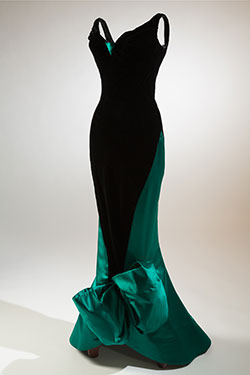
Charles James, evening dress, black velvet, green satin, circa 1955, USA, gift of
Robert Wells In Memory of Lisa Kirk.
Digital technology continues to transform the promotion, fabrication, and basic design
of fashion. From 3-D printing to advancements in sewable electronics, designers are
creating garments that can play music, answer telephone calls, and even monitor the
wearers heartbeat. In recent years, social media websites like Facebook and Twitter
have been redefining the limits of fashion branding.
The interplay of digital technology and fashion has only just begun. As fashion designer Hussein Chalayan has said, fashion will renew itself through technology, new fibers, new ways of making clothes. Without risk, nothing changes the world.
Fashion & Technology was organized by Ariele Elia and Emma McClendon.
The interplay of digital technology and fashion has only just begun. As fashion designer Hussein Chalayan has said, fashion will renew itself through technology, new fibers, new ways of making clothes. Without risk, nothing changes the world.
Fashion & Technology was organized by Ariele Elia and Emma McClendon.


